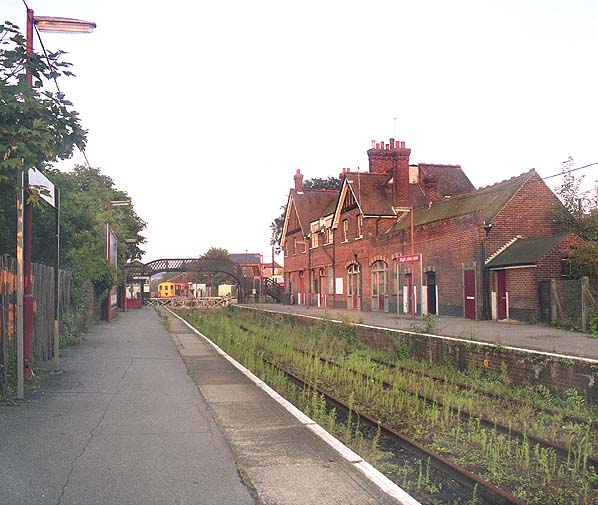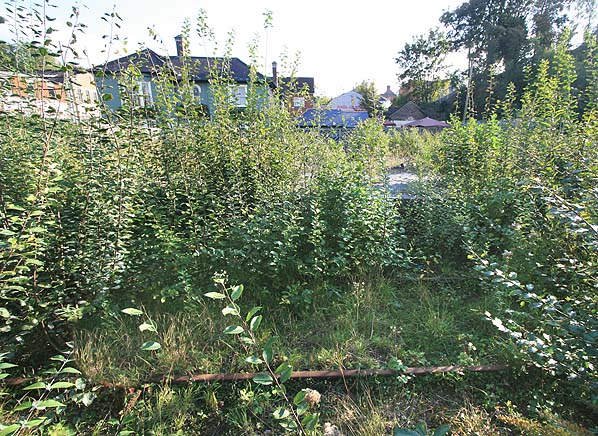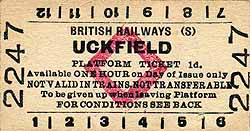
Station Name: UCKFIELD
|
| Date opened: | 18.10.1858 |
| Location: | On the west side of High Street |
| Company on opening: | Lewes & Uckfield Railway |
| Date closed to passengers: | 13.5.1991 |
| Date closed completely: | 13.5.1991 |
| Company on closing: | British Rail (Southern Region) |
| Present state: | At the time of writing the platforms and track remain in situ although overgrown. The station site is securely fenced with no public access and there is a proposal to redevelop the site as a 60 space car park for the new station. |
| County: | Sussex |
| OS Grid Ref: | TQ473208 |
| Date of visit: | July 1991, January 1992, 17.11.2005 & 5.10.2007 |
|
Notes: Uckfield opened as the terminus of a branch line from Lewes and soon became an important rail centre with passenger and goods traffic. The latter had previously been catered for by a cut from the Ouse Navigation up the River Uck where it terminated at Shortbridge. The line was later extended to Tunbridge Wells.
The resignalling of the line in conjunction with singling of sections of the Uckfield line took place in January 1990 when the intermediate boxes at Hever, Birchden Jn, Eridge, and Crowborough were closed. Uckfield box became a crossing box but was closed later when Uckfield station was resited. BRIEF HISTORY OF THE LEWES
- TUNBRIDGE WELLS WEST LINE
The line to Uckfield opened from Uckfield Junction on the 18th October 1858, 7 1/2 miles up the Ouse valley to Uckfield and within a year the LBSCR took over the independent company. For the first ten years the track ran from a junction off the line to Wivelsfield which had opened earlier in 1847. But this meant trains had to reverse at Lewes en route to Brighton and a new track was built in 1868 giving access to Lewes from the east.
This was a further part of the Brighton Company's strategy to consolidate the area against competition from the South Eastern. When a further line was opened from Polegate to Eridge south of Groombridge Junction in 1880 the LBSCR had achieved its objective. In 1878 powers were obtained for a 1 mile long spur between Ashurst Junction on the East Grinstead - Groombridge Line and Birchden Junction, 1 mile north of Eridge on the Uckfield line. This enabled Groombridge to be bypassed without a reversal there. It remained largely unused until the final piece of the jigsaw was put into place with the opening of the Oxted & Groombridge Railway's line from Hurst Green Junction south of Oxted to Ashurst Junction. The local company was incorporated in 1861 and taken over by the LBSCR in 1864 four years before the line opened in 1888.
After WW2 commuters and local passengers were on the increase, encouraged by a frequent service and competitive fares but by the 1960's the Beeching era had begun and in 1964 new timetables were introduced making travel difficult with long waits for connections, by now a common ploy to reduce the number of passengers. The railway board wanted to close the line south of Hurst Green Junction to Lewes, together with the branch to Tunbridge Wells West. This met with vigorous opposition from local authorities and private individuals. Eventually the Minister gave way and agreed closure between Uckfield and Lewes only and the date was fixed for 6th January 1969.
The railways then hired buses for a time and Barcombe Mills and Isfield stayed open to issue tickets. The buses could not negotiate the narrow winding road to Barcombe Mills, so the railways provided a taxi to take passengers from the railway station to the bus stop. But this was only after intending passengers had walked over a mile to the station to buy their tickets! The last train ran on 23rd February 1969 and buses finally
stopped on 6th May 1969.
The Wealden Line Campaign was launched in 1986 to fight for the full restoration of the train services between Lewes and Tunbridge Wells A blow to their campaign came in 1991 when Uckfield Station was resited to the north side of the level crossing. Initially the old station and route to the bypass was preserved in case it should be required for a future restoration of passenger service. Initially the local authority were enthusiastic about the restoration of the rail service between Uckfield and Lewes but in 1998 they decided that a land use policy to restrict development around the former route could not be justified. The future for the line now looks brighter however. The passenger traffic is increasing phenomenally and Network Rail's Route Utilisation Study on Electrification released in May 2009 suggests the line from Hurst Green to Uckfield as a candidate for electrification. This would undoubtably bring dividends such as increased popularity, a probable re-doubling and then a natural push towards reconnecting the line to Lewes. Various insiders at Network Rail have confessed that they are having difficulty maintaining services on the Brighton Main Line and they cite an extended and electrified Uckfield Line as being the only practical answer to their problems. It is also interesting to note that Network Rail's Kent R.U.S. states that their is a lack of ability for them to transport passengers between Kent and Sussex, describing the situation as "poor". Again, a revitalised Wealden Line, incorporating a re-opened Eridge to Tunbridge Wells section would be a practical solution. Tickets from Michael Stewart To see the other stations on the Eastbourne - Tunbridge Wells West line click on the station name: Barcombe Mills, Isfield, Buxted, Crowborough & Jarvis Brook, Eridge, Groombridge, High Rocks Halt & Tunbridge Wells West |

Photo by Nick Catford

The overgrown Lewes platform and track at Uckfield Station in October 2007
Photo by Nick Catford
Click here for more pictures of Uckfield Station

|
 Home
Page
Home
Page
| Last updated: Tuesday, 23-May-2017 09:36:53 CEST |
© 1998-2007 Disused Stations
|






4.jpg)
